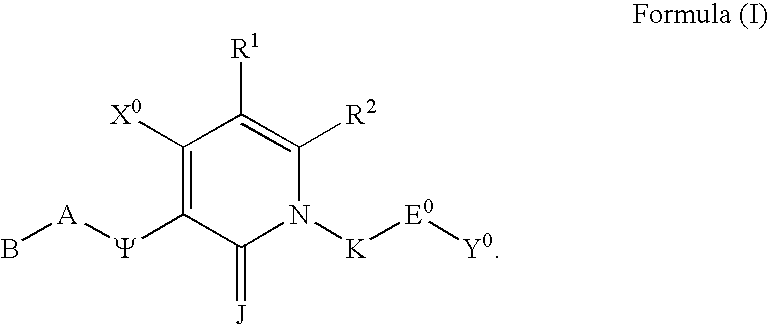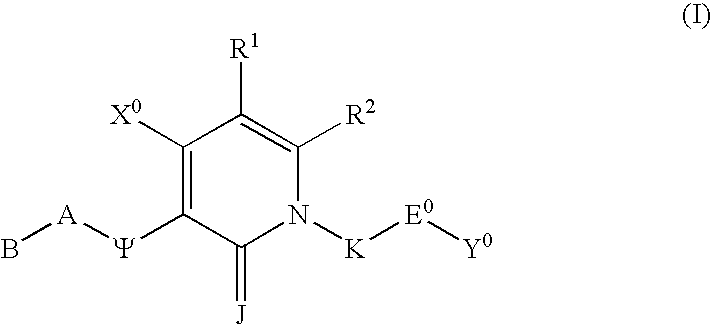Substituted polycyclic aryl and heteroaryl pyridones useful for selective inhibition of the coagulation cascade
a technology of heteroaryl pyridone and polycyclic aryl, which is applied in the direction of heterocyclic compound active ingredients, biocide, organic chemistry, etc., can solve the problems of ischemic necrosis of the tissue supplied by the artery, myocardial infarction or heart attack, tissue drained by the vein to become edematous and inflamed, and achieve the effect of preventing thrombosis and treating thrombosis
- Summary
- Abstract
- Description
- Claims
- Application Information
AI Technical Summary
Benefits of technology
Problems solved by technology
Method used
Image
Examples
example 1
EX-1A) 3-Nitro-1H-Quinolin-2-One (2.35 g, 12.37 mmole) in 50 ml anhydrous DMF was mixed with NaH 60% in mineral oil (0.59 g, 14.87 g), and the mixture was stirred for five minutes. To this mixture, 2-methyl-2-bromoacetate (2.27g, 14.84 mmole) was added dropwise. After stirring the reaction mixture for 2 hours at 20° C., DMF was removed via vacuum rotary evaporation to lead to a yellow oil residue. The residue was triturated in water to yield a yellow solid that was washed with water and hexane. The yellow solid was re-crystallized in ethylacetate to yield a yellow needle crystal solid (1.38 g) as the expected product, methyl-(3-nitro-2-oxo-2H-quinolin-1-yl)acetate. More product (1.20 g) was obtained from the mother liquor via silica gel flash chromatography to separate it from the O-alkylated side product (0.334 g). The desired product (EX-1A) yield was 80%. HPLC-MS (0 to 95% AcCN / 6 min @ 1.0 mL / Min @ 254 nm @ 50° C.): retention time 2.48 min, M+H+=263.2 for formula C12H10N2O5. 1H N...
example 2
EX-2A) 3-Benzylsulfonylamino-2-oxo-2H-quinolin-1-yl)acetic acid was coupled with benzyl-[[(4-aminomethylphenyl)iminomethyl]amino]carbamate hydrogen chloride salt using EDC, HOBt as coupling agents in the presence of DIEA in DMF. Work up procedure gave a white amorphous solid as the product, N-[[4-[(benzylcarbonyl-amino)iminomethyl]phenyl]methyl]-(3-benzylsulfonylamino-2-oxo-2H-quinolin-1-yl)acetamide. HPLC-MS (0 to 95% AcCN / 6 min @ 1.0 mL / Min @ 254 nm @ 50° C.): retention time 3.38 min. M+H+=638.3 for formula C34H31N5O6S. 1H NMR (400 MHz, CDCl3): δ 4.38 (s, 2H), 4.50 (d, J=6.0 Hz, 2H), 4.92 (s, 2H), 5.14 (s, 2H), 7.06 (t, J=7.2 Hz, 1H), 7.13 (t, J=7.6 Hz, 2H), 7.15-7.24 (m, 6H), 7.30-7.40 (m, 6H), 7.45 (m, 3H), 7.52 (m, 1H), 7.57 (d, J=8.4 Hz, 2H), 8.65(b, 1H), 9.09 (b, 1H).
Compound EX-2A (0.118 g, 0.185 mmol), p-toluenesulfonic acid mono hydrate (0.035 g, 0.185 mmol) and 10% Pd on activated carbon (0.029 g, 0.018 mmol) were mixed with 5 ml methanol. The mixture was stirred for 2 ho...
example 3
EX-3A) Methyl 2-[3-amino-2-oxo-2H-quinolin-1-yl]acetate, (9.1 g, 39.2 mmol) was mixed with Boc anhydride (9.41 g, 43.1 mmol), triethylamine (6 ml, 43.1 mmol) and DMAP (50 mg, 0.4 mmol) in 200 ml DCM. The reaction mixture was stirred at 20° C. for 14 hours. The reaction solution was washed with 1M citric acid solution twice, saturated sodium bicarbonate solution three times, saturated ammonium chloride once and it was dried over anhydrous MgSO4. After filtration and removing the solvent, the residue was treated with methanol. A white solid was precipitated. Filtration and washing with methanol, the pure product , EX-3A, was obtained as a white powder (9.90 g, 87%). HPLC-MS (0 to 95% AcCN / 6 min @ 1.0 mL / Min @ 254 nm @ 50° C.): retention time 2.85 min, M+H+=291.1 for formula C14H15N2O5. 1H NMR (400 MHz, Methanol-d4): d 3.76 (s, 3H), 3.82 (s, 3H), 5.15 (s, 2H), 7.09 (d, J=8.4 Hz, 1H), 7.26 (t, J=7.6 Hz, 1H), 7.43 (t, J=7.6 Hz, 2H), 7.61 (d, J=7.6 Hz, 1H), 7.96 (s, 1H), 8.39 (s, 1H). 13C...
PUM
| Property | Measurement | Unit |
|---|---|---|
| Molar density | aaaaa | aaaaa |
| Molar density | aaaaa | aaaaa |
| Molar density | aaaaa | aaaaa |
Abstract
Description
Claims
Application Information
 Login to View More
Login to View More - R&D
- Intellectual Property
- Life Sciences
- Materials
- Tech Scout
- Unparalleled Data Quality
- Higher Quality Content
- 60% Fewer Hallucinations
Browse by: Latest US Patents, China's latest patents, Technical Efficacy Thesaurus, Application Domain, Technology Topic, Popular Technical Reports.
© 2025 PatSnap. All rights reserved.Legal|Privacy policy|Modern Slavery Act Transparency Statement|Sitemap|About US| Contact US: help@patsnap.com



